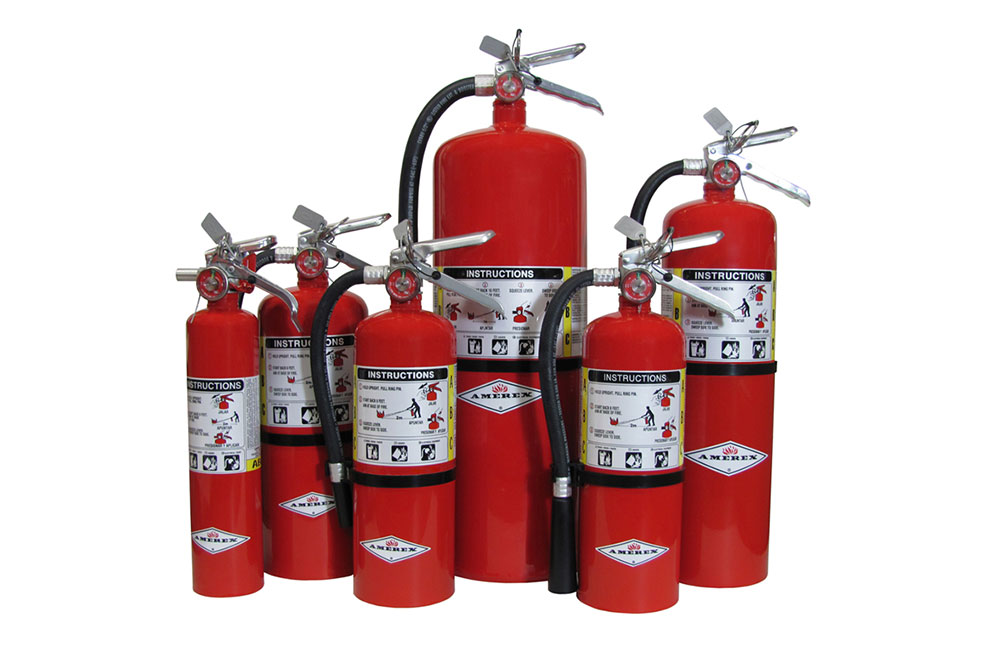 01
Apr
01
Apr
Fire Extinguisher Types
- 0 Comment(s)
- April 1, 2025
Portable fire extinguishers are key tools in managing fires, especially during the early stages. In the hands of a trained individual, they can protect both people and property from the dangers of fire. When choosing or using a fire extinguisher, it is important to understand the different types and the specific fires they can combat.
Below, we’ll break down fire extinguisher types based on the material inside the extinguisher, known as the extinguishing agent.
Classifications of Fires
Fires are categorized into classes depending on the type of material that is burning. Here are the primary fire classes:
- Class A Fires: In common materials such as wood, cloth, paper, rubber, and many plastics.
- Class B Fires: Caused by flammable liquids, solvents, oils, tars, alcohols, and gases.
- Class C Fires: Involving energized electrical equipment.
- Class D Fires: In combustible metals, including magnesium, sodium, and lithium.
- Class K Fires: Occur in cooking appliances involving combustible cooking media like oils and fats.
Each class requires a specific type of fire extinguisher.
Fire Extinguisher Types by Extinguishing Agent
Water Extinguishers
Water is the main agent used in many fire extinguishers, though some may contain additional additives to improve performance. One limitation of traditional water fire extinguishers is that they are not suitable for freezing temperatures.
If exposed to cold conditions, the water inside can freeze. This makes the extinguisher unusable. However, certain water-based extinguishers are designed with antifreeze additive. This allows them to function effectively in freezing environments.
Additionally, water fire extinguishers may include wetting agents to improve their effectiveness in fighting fires. These extinguishers are mainly used for Class A fires, such as those involving ordinary combustibles like wood, cloth, and paper.
Water mist extinguishers represent a specialized type of water extinguisher. Instead of releasing a solid stream of water, these devices discharge distilled water in a fine spray. This design is especially useful in environments where contaminants from unregulated water sources could cause damage to sensitive equipment or personnel.
Water mist extinguishers are commonly used in areas such as operating rooms, libraries, and museums–where protecting delicate items is a priority.
Check out a related video on the NFPA LiNK YouTube channel for more insights.
Foam Extinguishers (AFFF & FFFP)
Foam extinguishers, including FFFP (film-forming fluoroprotein) and AFFF (aqueous film-forming foam), are effective on both Class A and Class B fires. These extinguishers release foam rather than liquid or powder.
However, they are not suitable for use in freezing temperatures. One key benefit of foam extinguishers is their ability to float on the surface of Class B flammable liquids. This helps to prevent reignition by securing the liquid surface.
Foam extinguishers are particularly effective for deep flammable liquid fires–where the foam’s ability to cover the surface is crucial.
Carbon Dioxide (CO2) Extinguishers
The main advantage of Carbon Dioxide (CO2) fire extinguishers is that they leave no residue after use. This is especially important when protecting sensitive equipment like electronics.
CO2 extinguishers are commonly used in areas such as laboratories, food preparation spaces, and printing or duplicating areas. They are effective for Class B and Class C fires. CO2 is discharged as a gas or snow cloud, and its range is relatively short, typically between 3 ft and 8 ft (1 m to 2.4 m).
CO2 extinguishers are not ideal for use in outdoor environments with wind or areas with strong air currents. The agent can dissipate too quickly–reducing effectiveness. Additionally, the high concentration of CO2 required to extinguish a fire can reduce oxygen levels in confined spaces
For this reason, caution is advised when using these extinguishers in such environments.
Halogenated Agents (Halon and Alternatives)
Halon Extinguishers
Halon 1211 fire extinguishers use bromochlorodifluoromethane as an extinguishing agent. This agent works similarly to carbon dioxide in that it is effective in cold weather and leaves no residue after use.
However, it’s important to note that Halon production has been phased out due to its environmental impact, specifically its harm to the ozone layer.
Some larger models of Halon 1211 extinguishers are rated for Class A, B, and C fires. This makes them versatile. When compared to carbon dioxide, Halon 1211 is at least twice as effective on a weight-of-agent basis.
Upon discharge, Halon 1211 is released as a gas/mist with a range roughly double that of carbon dioxide. However, in windy conditions or areas with strong air currents, the agent may disperse too quickly. This reduces its effectiveness in extinguishing the fire.
Halon Alternative Clean Agents
There are various clean agents available that serve as alternatives to Halon. These agents share similar qualities with Halon: they are non-conductive, non-corrosive, and evaporate after use without leaving any residue.
Larger models of these clean agent fire extinguishers are also rated for Class A, B, and C fires. They are ideal for use around electronic equipment.
These agents are typically discharged as either a gas/mist or liquid. This evaporates quickly and has roughly twice the range of carbon dioxide. Like Halon, they can be affected by strong air currents or windy conditions–which may cause rapid dispersion and hinder extinguishment.
However, these clean agents have a much lower environmental impact than Halon and do not harm the ozone layer. This makes them more widely available.
Dry Chemical Extinguishers
Ordinary Dry Chemical
These extinguishers use a powder made of very fine particles as the extinguishing agent. Common types of agents include sodium bicarbonate and potassium bicarbonate.
Dry chemical extinguishers are specially treated to prevent issues such as packing and moisture absorption (caking). This helps maintain their ability to flow properly during use.
Multipurpose Dry Chemical
Multipurpose dry chemical extinguishers contain an ammonium phosphate-based agent. These extinguishers are effective for Class B fires in the same way as ordinary dry chemical extinguishers.
However, for Class A fires, the multipurpose agent has the added benefit of softening and sticking to hot surfaces. This allows the agent to adhere to burning materials and form a coating that smothers the fire by isolating the fuel from the air.
While this agent is effective in covering the surface of the fire, it has limited cooling properties. Due to its surface-coating nature, it cannot penetrate beneath the burning material.
As a result, deep-seated fires may not be fully extinguished unless the agent is applied directly below the surface. Alternatively, the burning material may need to be broken apart to help spread the agent more effectively.
Wet Chemical Extinguishers
The extinguishing agent in wet chemical fire extinguishers typically includes a solution of water combined with chemicals such as potassium carbonate, potassium acetate, or potassium citrate. These chemicals are conductive to electricity. The liquid agent usually has a pH of 9.0 or lower.
For Class A fires, the agent acts as a coolant. In the case of Class K fires, which involve cooking oils, the agent forms a foam blanket that prevents reignition. The water in the solution helps to cool the fats and hot oils. This lowers their temperature below the point where they would spontaneously ignite.
When discharged as a fine spray, wet chemical extinguishers directly target cooking appliances. This helps reduce the risk of splashing hot grease and eliminate the shock hazard for the operator. Additionally, wet chemical extinguishers improve visibility during firefighting efforts and help minimize cleanup afterward.
Dry Powder Fire Extinguishers
Dry powder fire extinguishers are designed specifically for Class D fires. These involve certain metals, and require special techniques for use.
The extinguishing agent can be applied either from the extinguisher or by using a scoop and shovel–often referred to as a hand-propelled fire extinguisher. These methods are tailored to handle the unique challenges presented by metal fires.

